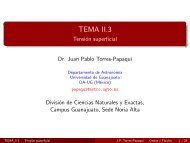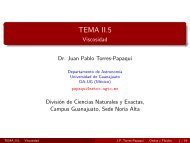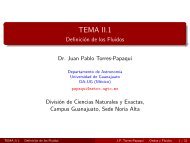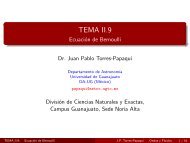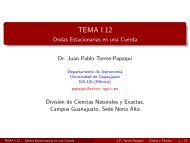MEXART: I. Sensitivity of the array and observable Inter Planetary ...
MEXART: I. Sensitivity of the array and observable Inter Planetary ...
MEXART: I. Sensitivity of the array and observable Inter Planetary ...
Create successful ePaper yourself
Turn your PDF publications into a flip-book with our unique Google optimized e-Paper software.
Scintillation index<br />
1<br />
0.1<br />
0.01<br />
0.001<br />
15.0 18.1 21.88<br />
26.56<br />
32.46<br />
40.08<br />
Elongation<br />
50.6<br />
Figure 2: Variation <strong>of</strong> scintillation index with solar elongation angle.<br />
68.02<br />
scintillation index, m, is related to ǫ as m ∝ sin(ǫ) −1.75 (Manoharan et al., 1995) as shown<br />
in figure 2. A lower limit on <strong>the</strong> scintillation index sets an upper limit on <strong>the</strong> elongation angle<br />
up to which scintillations can be measured. The lower-limit to <strong>the</strong> m <strong>and</strong> <strong>the</strong> corresponding<br />
upper-limit to <strong>the</strong> ǫ are given in <strong>the</strong> table 2, for different detection limits.<br />
6 Scintillation map <strong>and</strong> observing strategy<br />
The region set by <strong>the</strong> ǫ limit above are shown in figure 3. For an integration time <strong>of</strong> 50 ms, <strong>the</strong><br />
minimum detectable flux is 0.6 Jy. Assuming that most <strong>of</strong> <strong>the</strong> sources are close to <strong>the</strong> detection<br />
limit, <strong>the</strong> number <strong>of</strong> sources that would fall within each zone are given in <strong>the</strong> table 2. This is<br />
calculated assuming that <strong>the</strong> lines <strong>of</strong> sights with elongation angles less than 15 ◦ are not observed<br />
due to strong scattering. Since <strong>the</strong> telescope is a transit instrument, <strong>the</strong> above elongation angles<br />
correspond to a transit time (see <strong>the</strong> table 2). During <strong>the</strong> transit time <strong>the</strong> observations can be<br />
carried out. For a source <strong>the</strong> ON source time is about 5 mins. Assuming 10 mins <strong>of</strong> observing<br />
time for each source including <strong>the</strong> OFF source observations, <strong>the</strong> total data-time is about 31<br />
hours for 5σ <strong>and</strong> 34 hours for 10σ detection. To acquire <strong>the</strong> data within <strong>the</strong> transit time <strong>of</strong> <strong>the</strong><br />
IPS-zone <strong>the</strong> required receivers are 6 for 5 σ detection <strong>and</strong> 3 for 10 σ detection. The number<br />
<strong>of</strong> sources that can be observed with elongation angles less than about 75 degree are about 650.<br />
These sources can be observed using 7 receivers over a transit time <strong>of</strong> 10 hours.<br />
4




